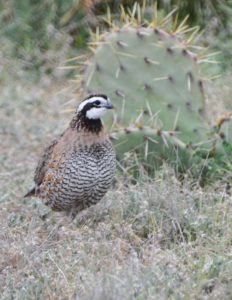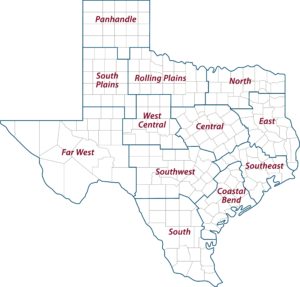Reduced wildlife numbers expected going into hunting season
- Writer: Adam Russell, 903-834-6191, adam.russell@ag.tamu.edu
- Contact: Dr. John Tomecek, 325-650-3520, john.tomecek@ag.tamu.edu
THRALL – Drought conditions throughout much of the state this summer likely will mean lower wildlife numbers this hunting season, said a Texas A&M AgriLife Extension Service expert.
Dr. John Tomecek, AgriLife Extension statewide wildlife specialist, Thrall, said deer, quail and turkey numbers would likely be affected. Fewer forbs and reduced nutritional value in browse and other food crops along with typical predation are contributing factors, he said. Hunters should also be careful not to over hunt quail broods.

Quail hunters should be mindful to not over hunt local birds as numbers declined due to drought. (Texas A&M AgriLife Extension Service photo by Steve Byrns)
“Hunters in areas that experienced drought conditions can expect reduced numbers because of the heat and lack of rain and nutrition on the ground,” he said. “Young animals will probably be a little poorly going into the season, though recent rains may help them bounce back a little. But generally, hunters aren’t going to see the quality on a region-to-region basis that they might have seen the last few years.”
Tomecek said he does not expect catastrophic herd declines in deer as happened during the 2011 drought. But along with fewer deer, hunters will likely see a decline in antler quality.
“Genetics play a role in antler quality, but the vast majority of antler production is nutrition,” he said. “It would take an aggressive supplementation regimen for a deer herd to make a difference because it’s very difficult to replace an entire diet with supplemental feed.”
The Texas Parks and Wildlife Department quail survey is not complete yet, but long-term AgriLife Extension studies show quail numbers dwindle during drought, Tomecek said. This means hunters and landowners should pay close attention to the quail they are harvesting to avoid a long-term detrimental effect on local bird populations.
Tomecek said landowners are very adept to self-regulation when it comes to quail, and that this season might be the time to dial back on harvest numbers.
“Historically, severe drought conditions can have a sharp effect on quail in the short-term,” he said. “Quail should have a lot of offspring compared to the number of adults during a typical year. So, hunters should age the birds in hand during hunts. If they see higher numbers of mature birds and not many juvenile birds, they may want to stop hunting for the season to avoid cutting into the brood stock too much.”
Turkey numbers will likely be affected by drought conditions, but hens and young birds have a dietary option – insects – that may assist a flock’s survival rate,Tomecek said.
“Turkeys don’t reproduce in high numbers like quail, so hunters might see smaller flocks,” he said. “Hens and younger birds have a more flexible diet and may have zeroed in on insects. We had a decent grasshopper crop this summer, and those birds may have made good use of them.”
Tomecek said dove season has been slow in many areas of the state, but migration numbers could rise quickly with a cold front.
“I would tell hunters to have their shells and shotguns ready for the first real cold front of the season,” he said. “Landowners who have millet, sorghum or another seed crops would be smart to hold off shredding some until then and cut heavy before the cold front. That might mean birds stay in an area for a day or two if there is extra food on the ground.”
AgriLife Extension district reporters compiled the following summaries:
CENTRAL: Most fields and pastures had armyworms, and producers were actively spraying between rains. Pastures and crops continued to recuperate following recent rains. Livestock were in good condition. Hay producers should be able to get one or two more cuttings. A majority of cotton producers were done harvesting. Nearly all counties reported good soil moisture. Overall crop, livestock, rangeland and pasture ratings were good in a majority of counties.
ROLLING PLAINS: Recent rains helped replenish soil moisture and fill stock tanks. Pastures and rangelands improved and were in fair to good condition. Armyworms were very active in pastures, lawns and newly sprouted wheat. Winter wheat planting picked up. Producers were applying fertilizer and defoliating cotton. Cotton started to bloom in some areas.
COASTAL BEND: No report.
EAST: Scattered thunderstorms paired with steady rains continued to replenish soil moisture levels across the district. Gregg County ponds were filling up, and conditions were extremely wet. Marion County reported ponds were still low as was the quality of grasses in pastures. Anderson County reported cotton was fair, and land preparation for wheat planting was at a standstill. Pasture and rangeland conditions were poor in Wood, Anderson and Marion counties and good in Sabine and Shelby counties. All other counties reported pasture and rangeland conditions were fair. Sabine County reported warm-season grasses rebounded, and producers were hopeful about forage and hay crops and chances of a good third cutting. Subsoil conditions were adequate apart from Marion, Angelina and Houston counties, which reported short conditions. Topsoil conditions were surplus in Panola, Gregg and Polk counties. Anderson, Marion and Houston counties reported short topsoil conditions, and all other counties reported adequate conditions. Anderson and Marion county producers continued supplemental feeding due to drought. Livestock were fair to good in Smith County with some supplementation taking place. Houston County cattle prices were up, and buyers were aggressive with continued optimism for wheat. Gregg County cattle prices were holding steady to lower than average overall. Armyworms were very destructive in all counties despite producers spraying. Cherokee and Panola counties’ producers were reporting the worst infestations they’d ever experienced. Anderson and Shelby counties reported insecticides became hard to find due to armyworm outbreaks. Feral hogs were still a problem in Anderson, Wood and Henderson counties. Horn files were out in full force in Anderson County.
SOUTH PLAINS: Recent frequent rains helped saturate the topsoil and subsoil, but most areas still needed more moisture. Rains varied across counties from 0.5 of an inch to 3-plus inches. Cooler temperatures and more cloudy days prevented moisture evaporation. Crops continued to mature. Producers began the peanut harvest. Armyworms damaged much of the hay crop. Cotton looked very good despite short moisture this season. Producers were beginning to utilize harvest aides and prepare for harvest. Winter wheat needed moisture. Some ranchers reported improved pasture conditions. Pastures and rangelands remained in fair to good condition. Cattle were in good condition.
PANHANDLE: Temperatures were near-normal with some moisture in areas. Rain events also brought fall like temperatures. More moisture was still needed throughout the district. Armstrong County was still very dry but was expecting to receive moisture. Sorghum started coloring, and some wheat was planted. Pasture conditions were still dry, but no fires were reported in the past couple of weeks. Carson County received some rain, but conditions were still very dry. Hall County received county-wide rain, which eased drought pressure and helped pasture and cattle conditions. Cotton looked good and continued to develop, but producers were concerned about fiber maturity due to cooler night-time temperatures. Lint yield potential remained very high. Cotton harvest aid applications were expected to start soon. Peanuts were being harvested. Ochiltree County received some general rainfall, which halted early corn harvest and wheat planting activities. Wheat already planted was off to an excellent start. Grain sorghum continued to develop with record-breaking yields expected. Harvest of early planted fields should begin soon. Soybean harvest was halted due to rainfall, but yields so far were very good.
NORTH: With the recent rain, most of the counties reported adequate topsoil and subsoil moisture. Over the district, reports of anywhere from 4-6 inches of rain fell during the reporting period. Almost every county reported armyworm numbers were almost insurmountable. Despite a vast outbreak of armyworms, farmers did not report significant damages to crops so far. Grasses were green, and pastures and hayfields had rebounded. Hay producers were ecstatic with recent cuttings. Livestock were in good condition.
FAR WEST: No report.
WEST CENTRAL: Rains of up to 2 inches were reported, but all areas needed more moisture. Pastures improved, and forage growth increased. Many producers were waiting for conditions to dry enough to plant small grain. Armyworm activity increased. The market continued an upward price trend with stocker steers and heifers selling $5 to $10 higher per hundredweight. Prices on feeder steers and heifers were steady to $2 higher per hundredweight. Packer cows and bulls were steady. Pairs and bred cows continued to grow in demand with improved grazing conditions and hay production potential.
SOUTHEAST: Rainfall replenished soil moisture. Livestock were in good condition. Some cotton was harvested and weathered the rain well. Wet field conditions in some areas halted cotton harvest, and defoliated cotton fields that received rains were seeing seeds germinating in the bolls. Armyworm numbers were high and were impacting pastures and hay fields. Rains helped green up pastures. Rangeland and pasture ratings varied from excellent to poor with good being most common. Soil moisture levels ranged from adequate to surplus with adequate being most common.
SOUTHWEST: Pasture and rangeland conditions improved significantly due to recent rains. The soil profile was fully saturated. Rivers, creeks and tanks were filled. Cotton farmers found it difficult to harvest due to recent rains. Livestock conditions responded favorably to increased forages. Producers in many counties were battling armyworms.
SOUTH: Parts of the district reported mild weather conditions with the continuation of adequate soil moisture levels. Some parts reported surplus moisture following rains. Rain amounts ranged from 3-21 inches for the reporting period. Very little field activity was reported due to rain. Conditions were good for many cotton producers, but it could be challenging getting the remainder of their cotton out. About 75 percent of cotton was harvested in some areas. Peanut harvest of early planted fields was slowed, and some Southern blight and leaf spot were reported. Armyworms came out aggressively. Pasture and rangeland conditions improved dramatically with recent rainfall. Stock tank levels increased, and forage conditions were improving in quality and quantity. Body condition scores on cattle were good and improving. Some producers reported field conditions should be suitable for wheat, spinach and cabbage planting soon with no additional rainfall. Pecans were reaching split shuck stage in some orchards. No supplemental feeding was reported.
-30-
The post Texas Crop and Weather Report – Sept. 25, 2018 appeared first on AgriLife Today.
